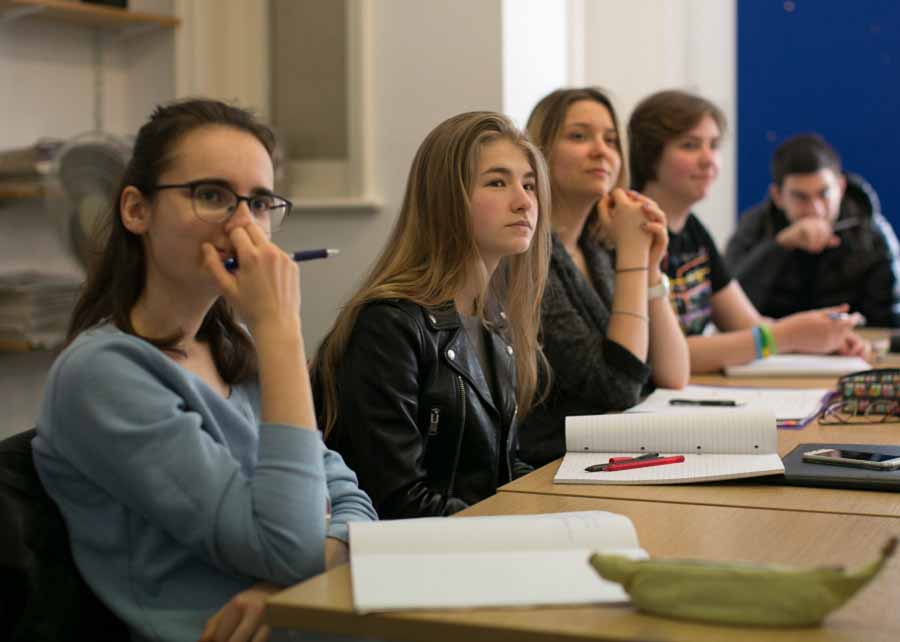IB or A Level?
In 1978 St Clare’s decided to stop teaching A Levels in favour of the then little known International Baccalaureate Diploma. We recognise the considerable advantages that the IB offers young people as they prepare for the next stage of their life.

What are the differences between these two qualifications?
- IB students take six subjects, three at higher level and three at standard level. These subjects are studied for two years and are examined at the end of that two-year period.
- In contrast, A Level students, usually take 3 or 4 subjects and the full two-year course of study is known as the A Level.
- The IB offers a broader education: there are six subject groupings and students have to take a subject from each of these groups:
- Language and literature
- Language acquisition
- Individuals and Societies
- Sciences
- Mathematics
- Arts or Electives
You can choose to study Music, Theatre or the Visual Arts from this group OR you can choose one of the following:- another language
- another subject from Individuals and Societies
- another science
This flexibility means that it is possible to take Biology, Chemistry and Mathematics – if you want to study medicine – plus literature, a language and a social science subject.
It is also possible to take unusual subject combinations – Italian, English, Chemistry, Mathematics, Psychology and Art, which would be difficult to replicate in an A Level school.
There are also a number of other requirements which are an integral part of the IB. Each student prepares a 4000-word essay based on an original piece of research and there is a compulsory Theory of Knowledge course which is also assessed. Finally, the IB involves a compulsory programme known as CAS (Creativity, Activity and Service). This involves taking part in Creative, Active or Community activities with a reflective writing component. It is impossible to be awarded the Diploma without satisfying this component.
Schools which offer the A Level will, of course include sporting, cultural and volunteering activities within their sixth form curriculum but there is no attempt to integrate these elements in the same way that this has been done with the IB.
How difficult is the A Level when compared to the IB Diploma?
- The highest possible score for the IB is 45 points – only 0.2% of students worldwide are able to achieve this each year. The pass mark is 24 points, which is achieved by only 78% of students worldwide each year. Compare this with the A Level where hundreds of schools and colleges are able to report a 100% pass rate when the results are published each year.
- According to the UCAS tariff, 45 points is the equivalent of 5 grade A* at A Level; 40 points is the equivalent of 4 grade A* at A Level and 35 points is equivalent to 2 grade A* at A Level and 1 grade A.
The percentage of students achieving a Diploma each year has remained constant over the last decade which indicates that, unlike the A Level, there has been little grade inflation.
When choosing a sixth form, in addition to grades students should look at the ethos of the school or college, the level of support given to students and the level of careers advice – all of which contribute to finding a school where a young adult will be happy and productive.
Melanie Moorhouse, Head of Careers at St Clare’s Oxford provides continuous advice and updates on her blog.
Further Reading
Model United Nations
For St Clare’s International Day, the IB students and staff attended the St. Clare’s Model United Nations’ Conference which was held at Oxford Town Hall. The objective for the day was for students to gather in committees to debate about the current world’s largest...
Happy Halloween
Our students were treated to every type of spooky meals and ghoulish grub today in the dining room; which ones would you choose? Chicken eyeballs with black cobweb spaghetti or scarecrow peppers stuffed with spaghetti worms Broken pork ribs with devil sauce or beef...
Students’ portraits in art exhibition
St Clare’s students have had their artwork included in a special exhibit in the University of Wisconsin, featuring children affected by the Syrian war.
We would be happy to discuss this in more detail
Send us your details so we can tell you more
